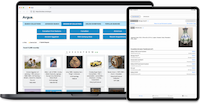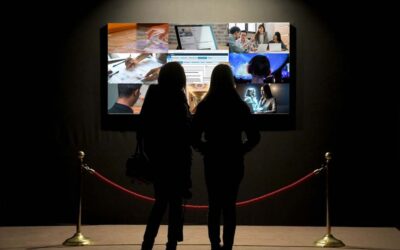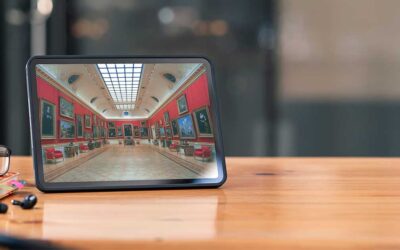How to Enhance Museum Collections Online with New Information

Rachael Cristine Woody
One of the wonderful things about museums is that the learning never stops.
There are always projects, exhibits, and programs in development that serve as constant instigators of research and generators of new information about the museum’s holdings.
But the question is: How much (if any) of this new information makes it into the museum Collections Management System (CMS)? If there isn’t a process in place to capture new information at the point of creation, it can quickly get lost.
Today’s post will outline the most common points of information creation, the challenges to consider, and possible solutions to put in place.
Identifying Points of New Information Creation
There are many points of information creation. The following list includes the most common points.
- Curatorial submitted content (blogs, articles, books, presentations, etc.)
- Exhibition panel and label finalization
- Staff research and work (role-specific, as well as blogs, articles, books, presentations, etc.)
- Conservation assessment, treatment reports
- External acquisition source (auction catalog, purchase paperwork, etc.)
As you consider this work, I encourage you to create your own list and add to it as the year progresses. This will aid in creating a strategy for data enhancement that can be built to match the museum’s natural cadence.
Fields to Use
Another area to consider is which fields to use for capturing new information. Sometimes it makes the most sense to add new information to an existing field, such as the Description field. Other times, it may make more sense to use a different existing field or even a custom field.
Here are some field examples to consider for each type of new information:
- Curatorial submitted content: Research Note, Curatorial Memo, Publication Text, Related Resources (with link).
- Exhibition panel and label finalization: Exhibit Label, Exhibit Panel Text.
- Staff research and work: Research Note, Catalog Memo, Publication Text, Related Resources (with link).
- Conservation assessment, treatment reports: Condition, Treatment Plan.
- External acquisition source: Provenance, Research Note, Catalog Memo, Publication Text.
The Challenges of Capturing New Information
There are a few challenges to consider when thinking through the logistics of capturing new information into the museum CMS. Those challenges are in the following areas:
- Staff capacity
- CMS access
Data enhancement requires staff time. This is why it’s important to be intentional about which areas of data enhancement balance with available staff capacity. Assuming there’s available staff time and interest, the next challenge to tackle is staff expertise in relation to editing records in the CMS. As several of the points for new information can often fall to non-CMS staff, there will need to be a mechanism for them to contribute their information.
How (and Who) Can Capture New Information in the CMS?
Everyone can be information creators, but not everyone will have access to the CMS. This part of the work will require the consideration of both access logistics as well as knowledge in how to use the CMS. There are two avenues that may prove workable:
- Those who created the information include as part of their workflow the addition of that information into the CMS.
- Those who created the information compile and submit it in a spreadsheet template that can be easily reviewed and ingested into the CMS by the appropriate staff member.
Both require a consideration of staff capacity, knowledge of the CMS, and editing access to the CMS. In order to be successful, the process will need to be as frictionless as possible. For those who can contribute the information directly, work with them to determine the appropriate fields to use and how they may upload the data most efficiently. For those who need to submit their data, create a spreadsheet with field options and work with them to determine the correct field and offer guidance on the data style for that field. As this enhancement is predicated on the information staff have already created or gathered, the workflow should be able to support a quick recording of the information and its delivery to the right place within the museum CMS.
Conclusion
Ultimately, providing additional avenues for data capture and access is in everyone’s best interest. If we can do so thoughtfully and with minimal impact on workload, the benefit will far outweigh the modest time impact on staff. Next week we’ll discuss how to leverage archival content to enhance museum collections online.
Additional Reading

Rachael Cristine Woody
Intrigued by this post? Please join us for the companion webinar, Enhance Museum Collections Online with “Hidden” Troves of Information, on October 30, 2024 at 11 a.m. Pacific / 2 p.m. Eastern. (Can’t make it? Register anyway and we will send you a link to the recording and slides afterwards). Register now or call 604-278-6717.
**Disclaimer: Any in-line promotional text does not imply Lucidea product endorsement by the author of this post.
Never miss another post. Subscribe today!
Similar Posts
From Preservation to Resilience: An Introduction to Building Resilient Digital Collections
Preserving a digital collection is a job that is never done. But what if we shifted our focus from preservation to building digital resilience?
Client Spotlight: MacLaren Art Centre Goes Beyond Collections Care to Access and Growth
“As our needs evolved, it became clear that our existing CMS was no longer working for us. Not only do we need to perform basic collections care, we need a system that will support public access, enable growth, and match our innovative strategies.”
Museum Collections Online: Digital Storytelling Blog Series Roundup
An overview of 10 blog post series that highlight how museums can leverage online collections and digital storytelling platforms, strategies, tools, and best practices.
How Museums Can Broaden Access and Improve Accessibility with Digital Storytelling
Museum expert Rachael Cristine Woody explains how digital storytelling expands access and improves accessibility of museum collections with inclusive multimedia formats.





Leave a Comment
Comments are reviewed and must adhere to our comments policy.
0 Comments